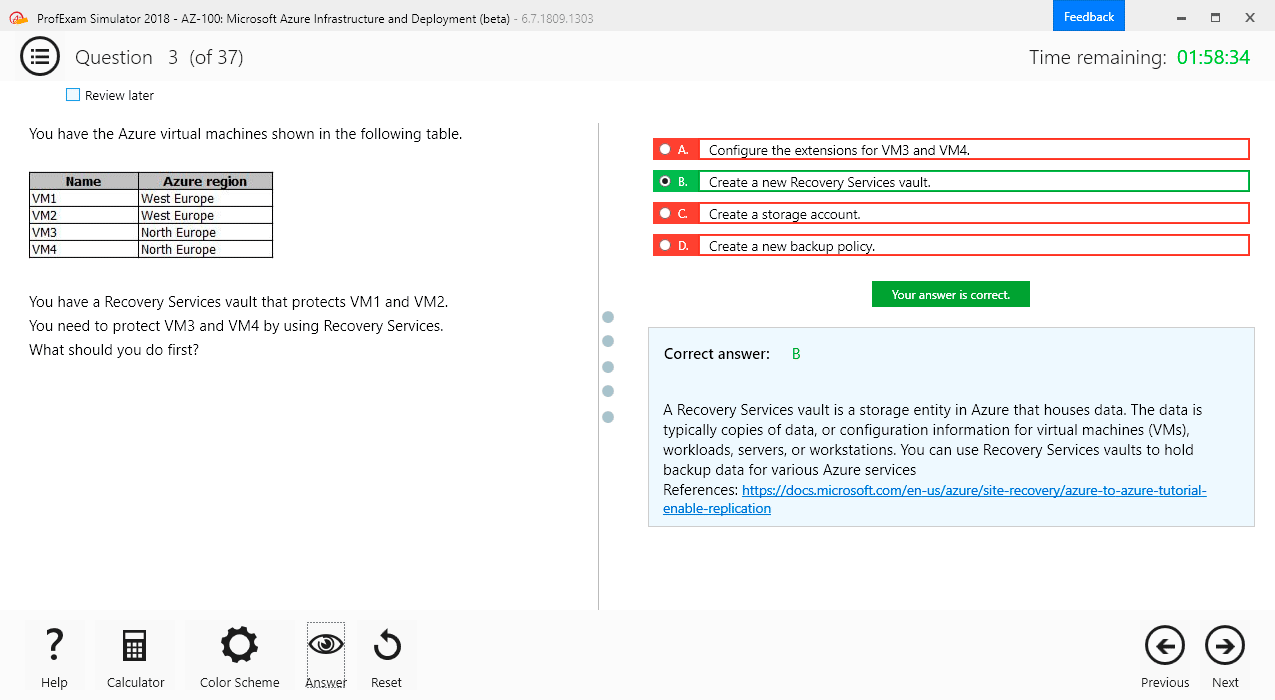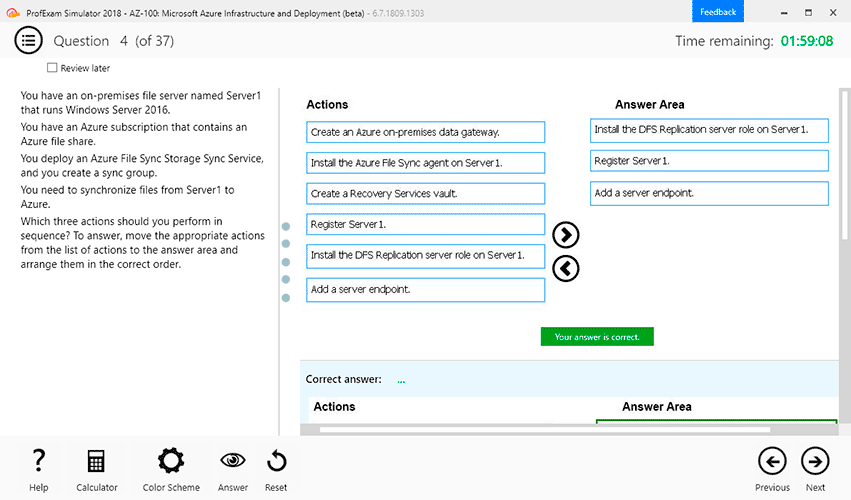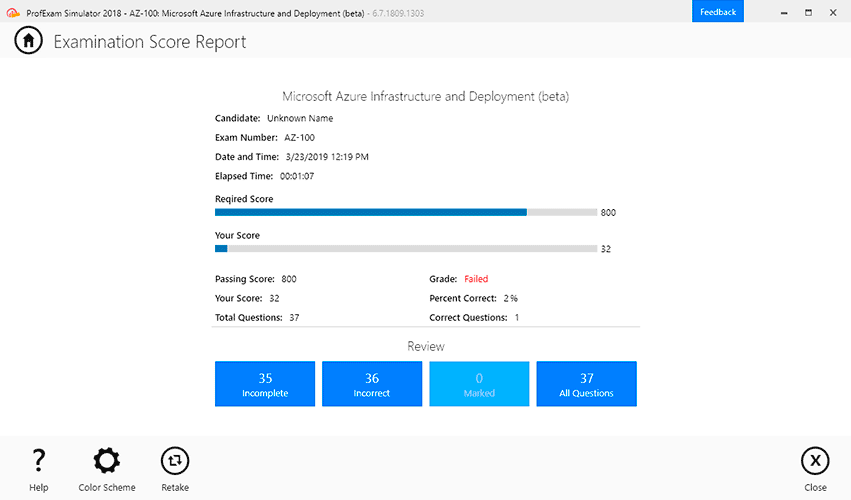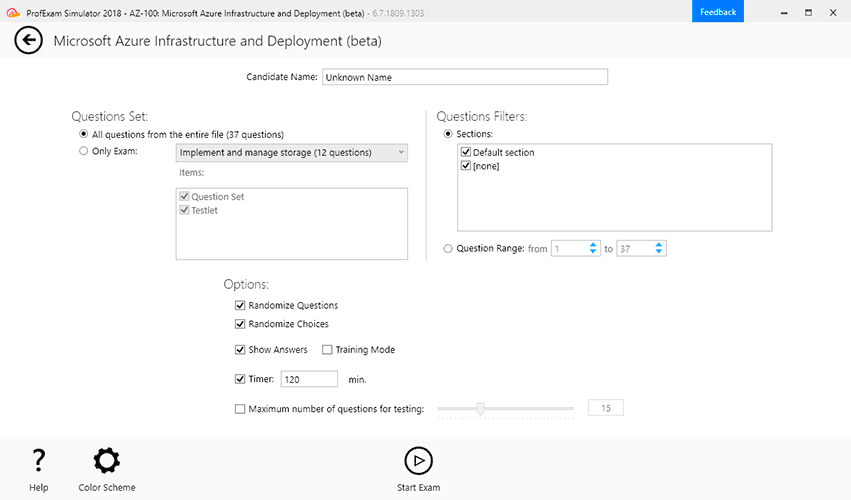File Info
| Exam | Professional Cloud DevOps Engineer |
| Number | Professional-Cloud-DevOps-Engineer |
| File Name | Google.Professional-Cloud-DevOps-Engineer.VCEplus.2024-08-18.115q.tqb |
| Size | 1 MB |
| Posted | Aug 18, 2024 |
| Download | Google.Professional-Cloud-DevOps-Engineer.VCEplus.2024-08-18.115q.tqb |
How to open VCEX & EXAM Files?
Files with VCEX & EXAM extensions can be opened by ProfExam Simulator.
Coupon: MASTEREXAM
With discount: 20%





Demo Questions
Question 1
You are developing the deployment and testing strategies for your CI/CD pipeline in Google Cloud You must be able to
- Reduce the complexity of release deployments and minimize the duration of deployment rollbacks
- Test real production traffic with a gradual increase in the number of affected users
You want to select a deployment and testing strategy that meets your requirements What should you do?
- Recreate deployment and canary testing
- Blue/green deployment and canary testing
- Rolling update deployment and A/B testing
- Rolling update deployment and shadow testing
Correct answer: B
Explanation:
The best option for selecting a deployment and testing strategy that meets your requirements is to use blue/green deployment and canary testing. A blue/green deployment is a deployment strategy that involves creating two identical environments, one running the current version of the application (blue) and one running the new version of the application (green). The traffic is switched from blue to green after testing the new version, and if any issues are discovered, the traffic can be switched back to blue instantly. This way, you can reduce the complexity of release deployments and minimize the duration of deployment rollbacks. A canary testing is a testing strategy that involves releasing a new version of an application to a subset of users or servers and monitoring its performance and reliability. This way, you can test real production traffic with a gradual increase in the number of affected users. The best option for selecting a deployment and testing strategy that meets your requirements is to use blue/green deployment and canary testing. A blue/green deployment is a deployment strategy that involves creating two identical environments, one running the current version of the application (blue) and one running the new version of the application (green). The traffic is switched from blue to green after testing the new version, and if any issues are discovered, the traffic can be switched back to blue instantly. This way, you can reduce the complexity of release deployments and minimize the duration of deployment rollbacks. A canary testing is a testing strategy that involves releasing a new version of an application to a subset of users or servers and monitoring its performance and reliability. This way, you can test real production traffic with a gradual increase in the number of affected users.
Question 2
You support a user-facing web application When analyzing the application's error budget over the previous six months you notice that the application never consumed more than 5% of its error budget You hold a SLO review with business stakeholders and confirm that the SLO is set appropriately You want your application's reliability to more closely reflect its SLO What steps can you take to further that goal while balancing velocity, reliability, and business needs?
Choose 2 answers
- Add more serving capacity to all of your application's zones
- Implement and measure all other available SLIs for the application
- Announce planned downtime to consume more error budget and ensure that users are not depending on a tighter SLO
- Have more frequent or potentially risky application releases
- Tighten the SLO to match the application's observed reliability
Correct answer: DE
Explanation:
The best options for furthering your application's reliability goal while balancing velocity, reliability, and business needs are to have more frequent or potentially risky application releases and to tighten the SLO to match the application's observed reliability. Having more frequent or potentially risky application releases can help you increase the change velocity and deliver new features faster. However, this also increases the likelihood of consuming more error budget and reducing the reliability of your service. Therefore, you should monitor your error budget consumption and adjust your release policies accordingly. For example, you can freeze or slow down releases when the error budget is low, or accelerate releases when the error budget is high. Tightening the SLO to match the application's observed reliability can help you align your service quality with your users' expectations and business needs. However, this also means that you have less room for error and need to maintain a higher level of reliability. Therefore, you should ensure that your SLO is realistic and achievable, and that you have sufficient engineering resources and processes to meet it. The best options for furthering your application's reliability goal while balancing velocity, reliability, and business needs are to have more frequent or potentially risky application releases and to tighten the SLO to match the application's observed reliability. Having more frequent or potentially risky application releases can help you increase the change velocity and deliver new features faster. However, this also increases the likelihood of consuming more error budget and reducing the reliability of your service. Therefore, you should monitor your error budget consumption and adjust your release policies accordingly. For example, you can freeze or slow down releases when the error budget is low, or accelerate releases when the error budget is high. Tightening the SLO to match the application's observed reliability can help you align your service quality with your users' expectations and business needs. However, this also means that you have less room for error and need to maintain a higher level of reliability. Therefore, you should ensure that your SLO is realistic and achievable, and that you have sufficient engineering resources and processes to meet it.
Question 3
Your company runs an ecommerce website built with JVM-based applications and microservice architecture in Google Kubernetes Engine (GKE) The application load increases during the day and decreases during the night
Your operations team has configured the application to run enough Pods to handle the evening peak load You want to automate scaling by only running enough Pods and nodes for the load What should you do?
- Configure the Vertical Pod Autoscaler but keep the node pool size static
- Configure the Vertical Pod Autoscaler and enable the cluster autoscaler
- Configure the Horizontal Pod Autoscaler but keep the node pool size static
- Configure the Horizontal Pod Autoscaler and enable the cluster autoscaler
Correct answer: D
Explanation:
The best option for automating scaling by only running enough Pods and nodes for the load is to configure the Horizontal Pod Autoscaler and enable the cluster autoscaler. The Horizontal Pod Autoscaler is a feature that automatically adjusts the number of Pods in a deployment or replica set based on observed CPU utilization or custom metrics. The cluster autoscaler is a feature that automatically adjusts the size of a node pool based on the demand for node capacity. By using both features together, you can ensure that your application runs enough Pods to handle the load, and that your cluster runs enough nodes to host the Pods. This way, you can optimize your resource utilization and cost efficiency. The best option for automating scaling by only running enough Pods and nodes for the load is to configure the Horizontal Pod Autoscaler and enable the cluster autoscaler. The Horizontal Pod Autoscaler is a feature that automatically adjusts the number of Pods in a deployment or replica set based on observed CPU utilization or custom metrics. The cluster autoscaler is a feature that automatically adjusts the size of a node pool based on the demand for node capacity. By using both features together, you can ensure that your application runs enough Pods to handle the load, and that your cluster runs enough nodes to host the Pods. This way, you can optimize your resource utilization and cost efficiency.

